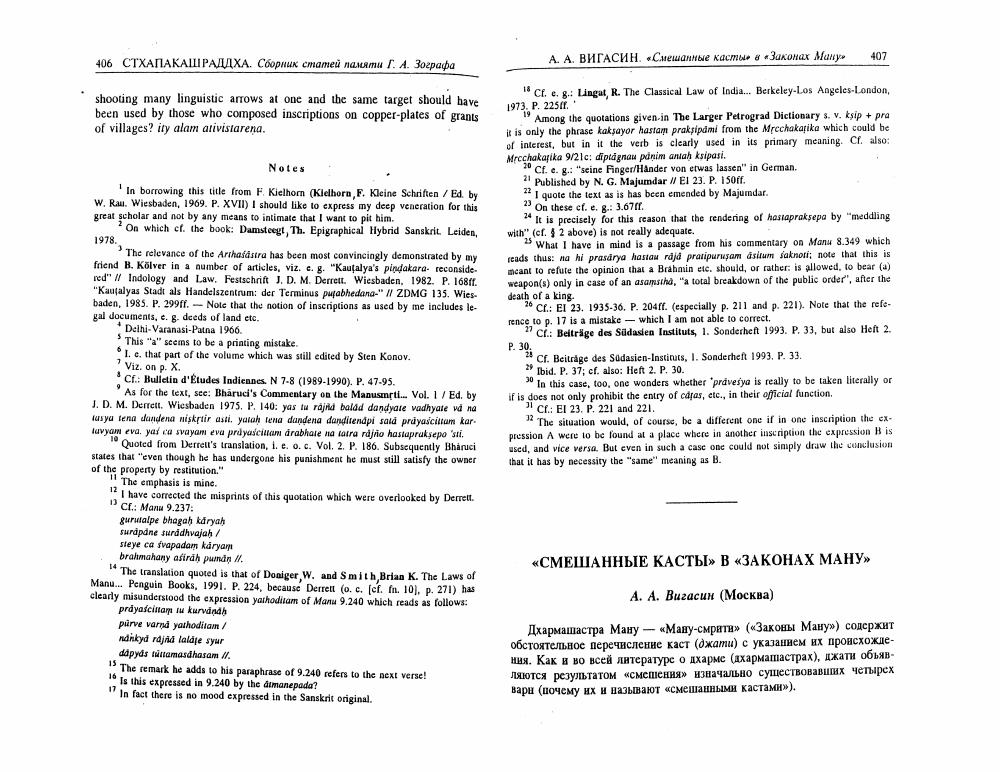Book Title: Epigraphic Notes Author(s): A Wezler Publisher: A Wezler View full book textPage 4
________________ 406 СТХАПАКАШРАДДХА. Сборник статей памяти Г. А. Зографа A. A. BYRACUH. <<Cuewannble Kacmow 6 <<Bakonax Manys 407 shooting many linguistic arrows at one and the same target should have been used by those who composed inscriptions on copper-plates of grants of villages? ity alam arivistarena. Notes 'In borrowing this title from F. Kielhorn (Kielhorn F. Kleine Schriften / Ed. by W. Rau. Wiesbaden, 1969. P. XVII) I should like to express my deep veneration for this great scholar and not by any means to intimate that I want to pit him. On which cf. the book: Damsteegt, Th. Epigraphical Hybrid Sanskrit. Leiden, 1978. The relevance of the Arthasastra has been most convincingly demonstrated by my friend B. Kolver in a number of articles, viz. e. g. "Kautalya's pindakara reconsidered" || Indology and Law. Festschrift J. D. M. Derrett. Wiesbaden, 1982. P. 168ff. "Kausalyas Stadt als Handelszentrum: der Terminus pufabhedana-" II ZDMG 135. Wiesbaden, 1985. P. 299ff. - Note that the notion of inscriptions as used by me includes legal documents, e. g. deeds of land etc. Delhi-Varanasi-Patna 1966. This "a" seems to be a printing mistake. I. e. that part of the volume which was still edited by Sten Konov. ? Viz. on p. X. Cf.: Bulletin d'Etudes Indiennes. N 7-8 (1989-1990). P. 47-95. As for the text, see: Bharuci's Commentary on the Manusmrti... Vol. 1 / Ed. by J. D. M. Derrett. Wiesbaden 1975. P. 140: yas lu rajna balad dandyate vadhyate va na las ya tena dandena nisksiir asti. yatah tena dandena danditenapi sata priyascittam karlavyam eva. yas ca svayam eva pruyascintam arabhate na taira rajno hastapruksepo 'sti. Quoted from Derrett's translation, i. e. o. c. Vol. 2. P. 186. Subsequently Bharuci states that "even though he has undergone his punishment he must still satisfy the owner of the property by restitution." 1 The emphasis is mine. "I have corrected the misprints of this quotation which were overlooked by Derrett. " Cf.: Manu 9.237: gurutalpe bhagah karyah surapane suradhvajah / sleye ca svapadam karyam brahmahany asirah puman ll. The translation quoted is that of Doniger W. and Smith,Brian K. The Laws of Manu... Penguin Books, 1991. P. 224, because Derrett (o. c. (cf. fn. 10), p. 271) has clearly misunderstood the expression yaihoditam of Manu 9.240 which reads as follows: prayascittam lu kurvanah purve varna yathoditam / nankya rajna lalase syur dapyas tuttamasahasam II. The remark he adds to his paraphrase of 9.240 refers to the next verse! " Is this expressed in 9.240 by the armanepada? In fact there is no mood expressed in the Sanskrit original. 18 Cf. e. g.: Lingat, R. The Classical Law of India... Berkeley-Los Angeles-London, 1973. P. 225ff.' " Among the quotations given in The Larger Petrograd Dictionary s. v. ksip + pra it is only the phrase kaksayor hastam praksipami from the Mrcchakasika which could be of interest, but in it the verb is clearly used in its primary meaning. Cf. also: Mrcchakarika 9/21c: diplagnau panim antah ksipasi. 20 Cf. e. g.: "seine Finger/Hander von etwas lassen" in German. 4 Published by N. G. Majumdar // El 23. P. 150ff. " I quote the text as is has been emended by Majumdar. 24 On these cf. e. g.: 3.67ff. " It is precisely for this reason that the rendering of hastapraksepa by "meddling with" (cf. SS 2 above) is not really adequate. >> What I have in mind is a passage from his commentary on Manu 8.349 which reads thus: na hi prasarya hasiau raja pratipurusam asitum saknori; note that this is meant to refute the opinion that a Brahmin etc. should, or rather: is allowed, to bear (a) weapon(s) only in case of an asamstha, "a total breakdown of the public order", after the death of a king. 20 Cf.: El 23. 1935-36. P. 204ff. (especially p. 211 and p. 221). Note that the reference to p. 17 is a mistake ---- which I am not able to correct. 4 Cf.: Beitrage des Sudasien Instituts, 1. Sonderheft 1993. P. 33, but also Heft 2. P. 30. 28 Cf. Beitrage des Sudasien-Instituts, 1. Sonderheft 1993. P. 33. - Ibid. P. 37; cf. also: Heft 2. P. 30. In this case, too, one wonders whether 'pravesya is really to be taken literally or if is does not only prohibit the entry of cajas, etc., in their official function. 5 Cf.: El 23. P. 221 and 221. >> The situation would, of course, be a different one if in one inscription the expression A were to be found at a place where in another inscription the expression B is used, and vice versa. But even in such a case one could not simply draw the conclusion that it has by necessity the "same" meaning as B. it The «СМЕШАННЫЕ КАСТЫ» В «ЗАКОНАХ МАНУ» A. A. Buzacun (Mockba) Axapmalactpa Mauy -- <<Many-cMpata>> (<<Zakon Mauy>>) colepxut обстоятельное перечисление каст (джати) с указанием их происхождения. Как и во всей литературе о дхарме (дхармашастрах), джати объявляются результатом «смешения» изначально существовавших четырех вари (почему их и называют «смешанными кастами»).Page Navigation
1 2 3 4
